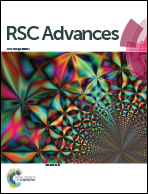Synthesis, characterization and chondrocyte culture of polyhedral oligomeric silsesquioxane (POSS)-containing hybrid hydrogels†
Abstract
Polyhedral oligomeric silsesquioxanes (POSS)-based hybrid hydrogels were successfully prepared via a fast azide-alkyne click reaction between octa-azido-functionalized POSS (OAPOSS) and alkyne-functionalized poly(ethylene glycol) (PEG). A series of hybrid POSS-PEG hydrogels with the highly ordered porous structures were achieved and the pore size could be well controlled by varying the PEG chain length to 3k, 6k and 10k. After immersing in phosphate buffered saline (PBS), POSS-PEG hydrogels exhibited a good water absorption capacity, and their swelling ratio increased with the increase of the PEG chain length. Rheological measurements indicated that all hydrogels exhibited the characteristics of an elastomer. The elastic modulus and ultimate stress (at break) were significantly enhanced with the increase of the PEG chain length which has been revealed by stress–strain mechanical analysis. In vitro cell culture showed that all POSS-PEG hydrogels could well support chondrocytes attachment, spreading and proliferation, especially for the POSS-PEG (10k) hydrogel. Thus, POSS-PEG hydrogels exhibited the potential for cartilage tissue engineering.


 Please wait while we load your content...
Please wait while we load your content...